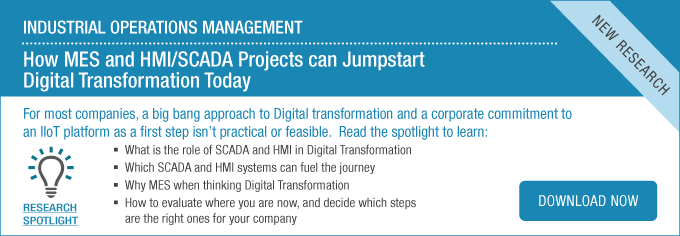 The Manufacturing Operations Management (MOM) industry has been greatly influenced over the last few years. Two major ways these changes have come to be are through:
The Manufacturing Operations Management (MOM) industry has been greatly influenced over the last few years. Two major ways these changes have come to be are through:
The MOM M&A activity has changed the competitive landscape.
Click here to speak with Andrew Hughes
Almost all large automation and software companies have acquired one or more of the independent MOM suppliers. Even ten years ago, many of them saw the need to complete their portfolios of software, whether it be in the process or discrete manufacturing industries. All the major discrete manufacturing automation companies and many of the suppliers of business software to these industries have full function MOM suites. The majority of these vendors sell to their automation customers to attempt to increase the share of wallet of their capital spend. They also sell to the wider manufacturing base particularly in markets where vendors they acquired had success.
There are still many independent MOM vendors not yet (or not willing to be) acquired. Some of these are specialists in just one or two industries; regulated industries such as life sciences and aerospace and defense tend to attract expert independents as domain knowledge and demonstrable experience are vital to success. However, a long-term growth strategy for independents is likely to require some diversification as the larger vendors attack new markets.
IIoT and MOM Apps
In our view of the seven lives of MOM, everything is trending towards MOM functionality running on IIoT platforms, some soon, others perhaps never. For example, it makes little sense for a manufacturer that has a Cloud-based Enterprise Quality Management System (EQMS) to run local quality tools on each MOM system it has across the company. Not only will it cost more and be hard to maintain, bust centrally managed quality will allow deeper and more sophisticated feedback to drive manufacturing quality across many plants. On the other hand, some fast data capture and critical control feedback applications are likely to remain in the plant for the foreseeable future.
The opportunities today to centralize functionality are many and, as we move further into the Cloud and the IoT, they will increase. Not only does it make sense, but IIoT platforms are starting to reach a level of maturity that building apps for manufacturing is becoming viable. Some platforms already include:
- Connectivity to talk directly to shop floor devices and a MOM system running in the plant,
- Cloud storage that can bring data together from a global manufacturing enterprise,
- Analytics capabilities that go far beyond what is typically available in MOM or Enterprise Manufacturing Intelligence (EMI) systems,
- Application Programming Interfaces (API) that provide open computing functionality to allow third parties to make full use of an IIoT platform’s capabilities.
In other words, the LNS Research definition of IIoT is becoming a reality. However, fully fledged MOM on such a platform is still a dream. Of course, the main IIoT platform players are developing (or porting) their MOM applications on the platform, but LNS Research considers that the market will only take off when third parties get involved.
Manufacturers that are considering Digital Transformation programs should look wider for their potential MOM apps. The time for specialist MOM suppliers and start-up entrepreneurs to develop on today’s IIoT platforms is now; this is also a test of the openness of the IIoT platforms. Will the vendors allow, encourage or try to crush the potential competition? Until now the big vendors have been very encouraging, indeed even financially supporting, entrepreneurs who are developing on the IIoT platforms. Let us hope this will continue.
Getting Beyond Obsolete Applications
Manufacturing engineers are a conservative breed, and this is demonstrated in almost every factory we see. There are inevitably many applications that have been running for years (or decades) that do a job but are hard to maintain, insecure, and usually running on completely unsupported hardware and operating systems. Systems like these can prove a real block to modernization and Digital Transformation because they cannot be integrated to new MOM systems. However, rebuilding them as apps on an IIoT platform might be a possible path to renewal. Conservative engineers will, we hope, be able to cope with gradual change from old to new!
Now is the time for all manufacturers to be considering their paths to Digital Transformation, whether slow and sure or going all in from the outset. IIoT apps can, and should be, a part of your Digital Transformation plans. Look beyond the platform vendors for apps that can make your journey more controlled, less expensive, and ultimately successful.
